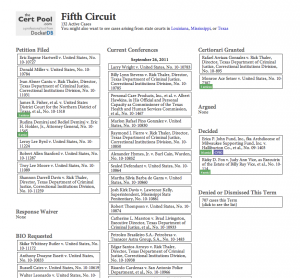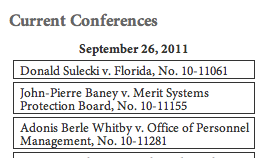If you found this blog with the search term “Supreme Court blog” (which a surprising number do), you’re in special luck today.
I’ve been working on a project to track the U.S. Supreme Court, much like my DocketDB project tracks the Texas Supreme Court. The site is CertPool.com. I put a simple version of it online late last year, and I’ve made improvements as I had time. The process has been quiet. I’m not sure that I ever mentioned it on this blog, although it has been noticed by the Volokh Conspiracy, and then by Crime and Consequences blog and a handful of others.
The construction is now far enough along to be interesting. If your practice extends beyond Texas — or if you’re just a really big appellate geek like me — here’s what you will find:
Slicing the docket by state or circuit of origin
This was the first feature I implemented. In part, I wanted to know which Texas cases that I’ve read (or blogged) about are being challenged. This sort of view might also be useful for state and local legal-beat reporters who want to share interesting (and local) cert petitions with their readers.
Petitions are broken out by state or circuit. For example, here are the pending U.S. Supreme Court cases from state courts in Texas. This set includes cases from the Texas Supreme Court (rare), Court of Criminal Appeals (common), or the intermediate courts of appeals (pretty common, after the Texas Supreme Court denies review). A different page shows the federal Fifth Circuit cases now pending in the U.S. Supreme Court.
Not visiting this blog from Texas? Then try this link instead. Or you can browse the list of the active cert petitions here.
Breaking it out by origin is nice. Even nicer, to my mind, is that these are also broken down by stage — has a brief in opposition (BIO) been requested? is the case set for conference? has review been granted?
The badges highlight which local cases have attracted amicus briefs. And you can see which cases have been relisted by the Court from one conference to the next — or which have been sitting a long time without action, signaling that the petition might be a candidate for a future per curiam or GVR (grant vacate and remand) in light of another pending case.
Those conference dates are important. Unlike many other Courts, the U.S. Supreme Court makes very public when a case is being discussed at conference. For counsel, that means you can plan to be waiting anxiously the next business day to see the orders list. (And for the press, it means you can know with great precision the most relevant time to run the story.)
The next conference date is September 26, 2011 — the so-called “Long Conference” after the Supreme Court’s long summer recess.
Individual docket pages and case tracking
Clicking a case name takes you to a basic docket page, which highlights the case events, the parties, and the attorneys. (( It doesn’t yet have links to the briefs, to the lower court opinions, or to the Supreme Court’s ultimate opinions in the case. That information is quite scattered for U.S. Supreme Court cases and can be folded in later. For now, I’m focusing on the unique aspect of CertPool.com, which is docket monitoring. ))
The real find here is in the very top right, which (for active cases) is a link to an RSS feed of case events for the case. If you subscribe to this RSS feed in whatever software you prefer (such as Google Reader, your browser, or even your email program), you will get updates about new case events.
You can subscribe to individual case updates, as you see fit, without having to worry about an account. (( Tracking Texas cases on DocketDB required you to create an account, which made it easy for users to manage a complex tracking list and for me to send email updates. I may add an account layer to CertPool.com later, because it can power much more sophisticated tracking than RSS. ))
The RSS feature was inspired by a post I read a couple of years ago from the Sunlight Foundation about how they would redesign the Supreme Court’s site. (Some of the other features mentioned in that post are already available for my Texas-focused DocketDB site.)
Amicus and CVSG information
There are some basic amicus-watching features on Cert Pool. You can see which cases have attracted at least one amicus brief at the Supreme Court cert stage.
There is a separate list highlighting the cases in which the U.S. Supreme Court has requested the views of the U.S. Solicitor General (known as “CVSGs”).
What comes next?
If you’re a power user of DocketDB’s Texas site, you’ll notice some things missing from CertPool.com. It doesn’t yet break out voting patterns of the Justices (one of my favorite features of the Texas site). Unlike the Texas site, it doesn’t yet display the newspaper articles or blog posts about each case. And there isn’t yet a way to tag or browse pending cases by issue. (( And it also doesn’t yet cover the “original proceedings,” such as disputes between States over their territorial borders. ))
Some feedback from you would help me decide what to implement next. I’d like to have a few more features in place before the U.S. Supreme Court comes back into session this October.






1 response so far ↓
1 Warren Hoskins // Aug 29, 2011 at 3:20 pm
Thank you! As a Legal Assistant who sometimes must hunt up cert petitions, or briefs on them, you are providing a unique resource. I like the current “no account required” aspect, although I understand why using accounts could help the users — but being free of an account requirement greatly speeds my access to the important information you are parsing out for us.